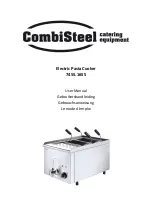
F18 SB
Connections
23
3)
Dry operation
Rotary vane pumps can operate in dry condition
only for very short periods of time (a few seconds).
In case of prolonged operation without water the
gasket is not cooled properly and reaches very
high temperatures, until it breaks. The most likely
consequence is a remarkable leak visible through the
4 drain holes close to the clamp. For potential lack of
mains water, it is recommended to install a minimum
pressure switch upstream of the pump. In case of feed
from a tank, it is advisable to equip it with a suitable
level control.
4)
Cavitation
Cavitation shows when feed water flow does not
match the pump design characteristics: the most
frequent causes are clogged filters, pipes with
insufficient diameter, several users on the same line.
The solenoid valve (generally installed upstream of
the pump and filters) must always be opened before
the pump activation, to avoid cavitation. For the same
reason, when the pump stops, the solenoid valve
closing must be delayed.
The most noticeable effect is an increase in noise. If
this condition persists, the consequences are similar to
those with dry operation.
5)
Hot water return
Sometimes the non return valve, provided on the
hydraulic circuit of the machine between the pump
and the boiler, is defective. In this case the pump
may remain in contact with hot water (90-100°C
- 194/212 °F) and be damaged because of the
different expansions of the material used. Lock-out is
the most frequent consequence.
6)
Unsuitable connections
The pumps may have 3/8”NPT (conical) or GAS
(cylindrical) unions. Sometimes unions and nipples
with different threads from those recommended are
used, and the sealant or Teflon must complete a seal
made only with a few turns of thread. If the union
is forced it is possible to create chips; if excessive
sealant is used, the extra quantity may enter the pump
body. In both cases damage may be caused.
7)
Pressure strokes
To avoid pressure strokes, if the solenoid valve is
installed after the pump delivery, it must be opened
in advance with respect to the pump activation.
For the same reason, when the pump stops, the
solenoid valve closing must be delayed.
A pressure stroke may break graphite parts and
damage mechanical seal causing the pump lock-out
and leaks.
8)
Handling
The accidental fall of the pump may cause dents
and deformations such as to compromise the
tight internal tolerances. For the same reason it
is necessary to pay the utmost attention when the
pump is clamped for the assembly or disassembly
of the unions.
9)
Limescale deposits
If the water pumped is particularly calcareous and
is not pre-treated with ion exchange resins or other
effective systems, limescale may deposit inside the
pump.
Limescale formation increases when the pressure
relief valve is used as flow rate regulator: the
greater the recirculation of water, the faster the
process.
Limescale deposits may cause a progressive pump
hardening and in some cases its lock-out or a
pressure reduction due to an incorrect modulation
of the pressure relief valve.
To limit this problem, it is advisable to use
pumps with flow rate matching the hydraulic
circuit features. In some cases it is advisable to
periodically perform a descaling treatment with
proper acids.
















































